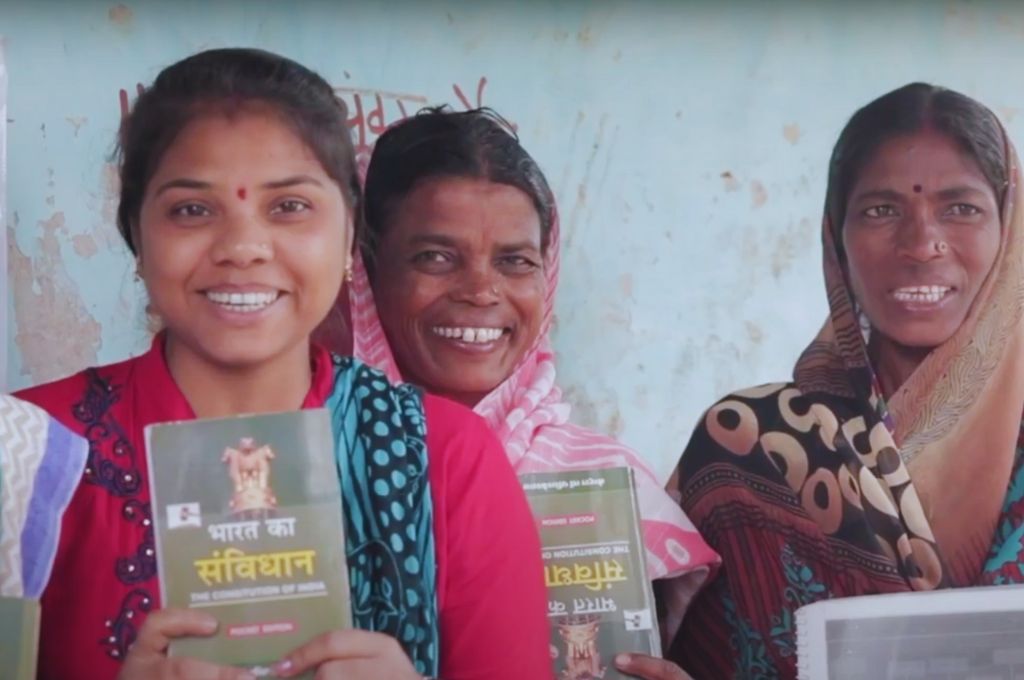In the quest for social impact, community building and platform creation are crucial strategies for nonprofits. The power of shared values, the vibrancy of collective action, and the sustainability offered by a community-centric approach can help amplify the reach and resonance of an organisation’s mission.
These strategies are the equivalent of turning a single powerful gorilla into a herd of nimble deer, with the organisation acting as a life-giving oasis. Let’s explore how leadership can guide this transformation using the idea of fractals.
Fractals are shapes in geometry that repeat the same pattern on different scales. Leadership is much like this. It’s not a one-way journey but a process that needs constant refining and adjusting, just like a fractal shape that keeps refining itself. Small changes in the beginning can lead to a significant difference later. Similarly, in a community, small decisions can create large effects.
Consider an instance where a leader’s values differ slightly from the organisation’s. At first, it may not be a reason for concern, causing only small ripples. But as this difference is repeated, it can create larger problems in the organisation, leading to confusion and inefficiencies. Over time, this slight difference can become a big issue, leading to the failure of the organisation.
I’ve learned from my experiences that leadership is like a fractal. It starts with one person making a change, which then affects those around them. Here are six ways in which leaders can help their communities grow and make a bigger impact.
1. Sharing core values
Community building begins with identifying and articulating your organisation’s core values. These values serve as the lifeblood that guides the community’s interactions, behaviours, and goals. It’s essential to understand that these core values aren’t merely imposed from the top but rather emerge naturally as an embodiment of the team’s shared beliefs, experiences, and aspirations.
The values thus formed become the common thread that connects diverse individuals, magnetically attracting those with similar beliefs and instilling a sense of camaraderie and shared identity within the community.
These values also give everyone a common language and frame of reference, guiding their actions towards achieving collective goals. This process is not a one-off event but a continuous exercise requiring constant introspection, mutual conversations, and a deep understanding of the community’s mission and vision.
Each member must live and breathe these values, and not just pay lip service to them. This can only happen when they are shared openly, regularly, and with conviction. Leaders for their part should incorporate these values in all communications and demonstrate them through actions.
Socratus, an organisation that works towards arriving at political solutions by bringing together all key agents who are the proponents of competing schools of thought, undertook an exhaustive process of reformulating and crystallising its core values, involving everyone from the senior management to all levels of the organisation. This process aimed to ingrain these values in the organisation’s collective conscience and is consistently revisited in weekly meetings.
The aim is not to achieve a fixed set of values but to nurture a living ethos that resonates with the community.
Similarly, Agami, a nonprofit that works towards innovation in law and justice, has integrated service leadership into their operations and community interactions, reflecting the organisation’s core values. Arghyam uses its mission of providing ‘safe, sustainable water for all’ as a guiding star, helping them discern whether their actions mitigate or aggravate issues. By conducting regular dialogues with stakeholders and beneficiaries, Arghyam ensures alignment with its mission of water security.
Articulating and sharing core values is an ongoing journey. The aim is not to achieve a fixed set of values but to nurture a living ethos that resonates with the community, evolves with it, and guides it towards a shared vision.
2. Encouraging unexpected connections
Serendipity—the occurrence of beneficial events by chance—can fuel innovation and foster deep connections within the community. It is the impromptu conversation at a networking event, the unexpected collaboration from a casual chat, or the innovative idea sparked by a chance meeting. Serendipity brings novelty and spontaneity, allowing diverse ideas and perspectives to mingle and generate unique solutions.
As leaders, the task is to architect an environment that nurtures these moments and promotes open dialogue and cooperation.
Creating ‘collision spaces’ where members can cross paths, interact, and collaborate is essential in fostering this culture of serendipity. These are not necessarily physical spaces but occasions, platforms, or environments that encourage and facilitate unexpected interactions and exchanges among community members. This could take shape in various forms—community meetups, workshops, online discussion forums, virtual coffee breaks, or social gatherings.
As leaders, the task is to architect an environment that nurtures these moments and promotes open dialogue and cooperation. This involves striking a delicate balance between structure and freedom—enough structure to provide a sense of order and coherence, and enough freedom for members to explore, express, and experiment. It also includes crafting an atmosphere of psychological safety where members feel seen, heard, and valued—spaces where they find it safe to voice their ideas and concerns, take risks, and make mistakes.

3. Building trust in the community
Building culture transcends merely assembling individuals around common interests or goals. Instead, it is rooted in creating an environment where care and trust are the foundations of every interaction, relationship, and initiative.
Leaders play a crucial role in this process. Their task extends beyond simply setting rules or defining boundaries; they must embody and model the behaviours they wish to see reflected within the community. This means constantly demonstrating empathy, practising active listening, offering support, and extending kindness and respect to all members. Furthermore, leaders must reinforce these behaviours through effective policies, constructive practices, and responsive feedback mechanisms.
Investing in trust is equally essential. Building trust is not an overnight process; it requires persistent and earnest efforts, transparent and open communication, and a willingness to face conflicts respectfully and constructively. Trust is built and sustained through consistent actions that validate the words spoken. And as trust grows, members become more willing to contribute, collaborate, and take risks, knowing they are in a safe and supportive environment.
At Agami, camaraderie and trust between colleagues and external partners is built through activities such as retreats, offsites, and informal meetups. Responsiveness to user needs and addressing issues respectfully, even when they can’t be resolved, are part of the leadership’s approach at Pratham Books to cultivate user loyalty.
4. Developing a platform for engagement
Platforms serve as a communal space or ‘watering hole’ for your community, where members gather, interact, learn, and collaborate.
These platforms often emerge organically from the needs and aspirations of the community rather than being predetermined structures. Therefore, they must not merely be technical solutions, but instead offer a space that nurtures a sense of belonging and encourages co-creation.
Community members should feel empowered to contribute to, innovate within, and take responsibility of the platform’s development and governance. This active participation deepens engagement and creates a stronger sense of ownership and accountability. It results in a platform that evolves with its users, ensuring its relevance, utility, and longevity.
Pratham Books developed StoryWeaver by observing how translators work offline and replicating this process online, making the platform intuitive and responsive to the needs of marginalised users. Arghyam amplified community capabilities by creating digital spaces to make skills training data visible and reusable at scale. This approach also fostered collaboration between government departments previously operating in silos.
5. Getting ready for decentralisation
The journey towards a community-centric model is a significant transformational process that involves rethinking and reorienting traditional organisational structures. It necessitates the shift from a hierarchical, control-based approach to a more collaborative, decentralised model, embracing shared ownership and governance.
This shift is not just operational but also cultural. It requires a change in mindset among the leadership and individual team members. It’s about redefining power structures and creating an environment that allows community members to shape the organisation.
A shift towards real decentralisation makes the organisation more resilient and adaptable in the face of change.
Indus Action, for instance, is working towards a future where regional teams operate autonomously and are independently funded, while the central team focuses on specialised functions such as technology. Pratham Books has adopted a light-touch governance approach for their StoryWeaver platform, employing mechanisms such as red flagging to maintain quality while encouraging open contribution. The organisation believes in collective stewardship, allowing the community to control the platform with minimal gatekeeping.
Such a shift towards real decentralisation—handing over ownership and agency to the community members—makes the organisation more resilient and adaptable in the face of change. By embracing decentralisation, the organisation truly becomes a platform that is of the community, by the community, and for the community.
6. Becoming a gardener
In a community-focused model, leaders transition from being the central authority to adopting the role of a ‘gardener’, often both within the host organisation and in the larger community.
Much like a gardener who cultivates a thriving ecosystem, leaders provide the necessary resources, conditions, and support for growth but also step back to allow the community to take the lead and evolve organically. This means creating opportunities for members to spearhead initiatives, mentor others, and even make mistakes from which to learn and grow.
But it’s more than just stepping back. It’s also about being attuned to the changing needs and dynamics of the community. It involves listening, observing, and offering targeted interventions when necessary, not unlike a gardener who prunes a tree or enriches the soil. Leaders need to maintain a hands-off, eyes-on approach, nurturing the environment while respecting the autonomy and individuality of its members.
Ashoka recognises individuals in the ecosystem who spotlight others’ needs without pushing their own agendas. Ashoka believes it serves as magnets, bringing together different stakeholders. At CIVIS, the leadership encourages organisations to cultivate volunteers’ passions, encouraging them to take ownership of the work rather than focusing on internal scaling.
Building communities is a journey of learning, adapting, and growing. The most successful organisations are those that enrich and are enriched by their communities. By embracing this fractal approach, leaders can help their communities become more resilient, creative, and impactful.
So, what patterns will you adopt to grow a thriving community? What new possibilities could your leadership unlock?
—





